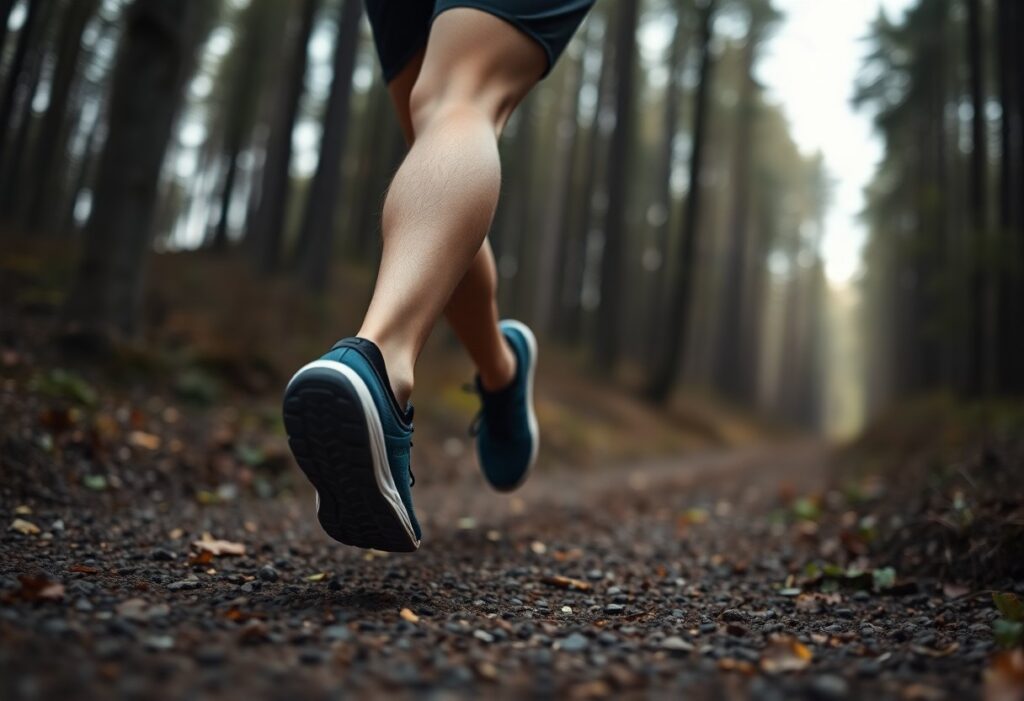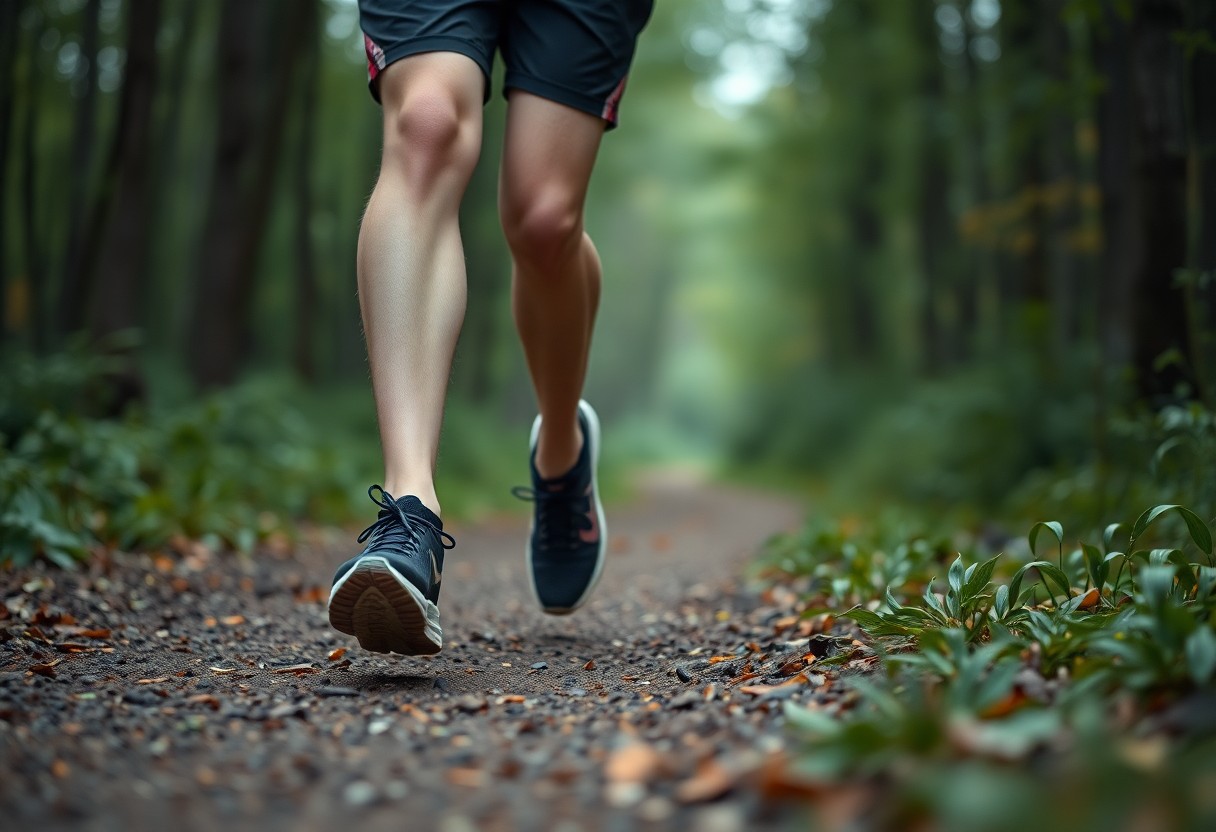
The alarming rates of injury rates among trail runners can reach as high as 62% annually. This concerning statistic is often linked to the selection of inappropriate footwear. To improve your performance and reduce the risk of injury, it is crucial to understand the biomechanics of minimalist footwear and its interaction with uneven terrain. The utilisation of wearable technology can effectively monitor key metrics such as foot strike dynamics and load patterns. Alongside personalised training programmes, you can enhance foot strength and endurance. This article explores how to leverage biomechanical insights and innovative technology to implement effective injury prevention strategies.

Make Informed Footwear Choices to Elevate Your Trail Running Skills
Successfully navigating the diverse and rugged terrain of trail running while wearing minimalist footwear transcends merely selecting the appropriate shoe; it demands a comprehensive understanding of your own biomechanics. Ignoring the specific challenges posed by various surfaces can significantly elevate your risk of sustaining an injury. As foot strike patterns and descent techniques differ, it is essential to adjust your running technique accordingly to maintain peak performance and minimise potential setbacks. By integrating knowledge of your biomechanics into your training regimen, you can make informed choices that will enhance your trail running experience.
Examine Biomechanical Foot Strike Patterns on Complex Trails
The dynamics of foot strikes can vary dramatically when traversing intricate landscapes. Runners opting for minimalist footwear often exhibit a remarkable 23% higher incidence of midfoot strikes on uneven trails compared to the mere 8% observed with conventional running shoes. This adaptation may enhance your stability on challenging surfaces; however, it is accompanied by a 37% increase in metatarsophalangeal joint flexion angles, which underlines the necessity for strengthening your foot muscles to improve endurance and diminish injury risk. By comprehending these dynamics, you can tailor your running form to achieve better performance and reduce the likelihood of injury, ensuring you remain resilient on demanding trails.
Evaluate Descent Mechanics and Their Impact on Ground Interaction
The mechanics of descending from elevations play a crucial role in influencing your performance and injury risk while trail running. Wearing minimalist footwear can result in a notable 42.191 BW/s increase in vertical loading rates on steep 15% declines, particularly when compared to flat asphalt surfaces. Moreover, this surge in loading leads to increased lateral toe engagement, which has been noted to be 11% greater on loose gravel than on structured surfaces, highlighting the intensified demands on the structural integrity of your feet during descents. As you navigate technical trails wearing minimalist shoes, the biomechanics of your feet engage in a distinctly different manner.
The heightened vertical loading rates during descents may cause increased fatigue in your foot muscles, amplifying your susceptibility to injuries. Additionally, significant alterations in toe splay patterns require enhanced proprioception and muscle coordination, ensuring you remain responsive to the varying terrain beneath your feet. By focusing on these factors, you can effectively prepare your body to tackle the challenges of diverse trails while optimising your overall running performance and safeguarding against injuries.
Thoroughly Assess the Limitations of Wearable Technology in Trail Running
While wearable technology has revolutionised the realm of trail running, it poses significant challenges in accurately tracking performance metrics. The variability of terrain conditions, including steep drops and uneven surfaces, complicates data collection and interpretation. For example, wearable devices often struggle to provide consistent vertical oscillation measurements due to fluctuating ground conditions, which can result in misleading insights regarding your gait and running efficiency. Acknowledging these limitations is crucial for making informed decisions about your training methods and ensuring a more reliable assessment of your performance metrics.
Investigate Discrepancies in Data Accuracy Among Leading Performance Devices
Notable discrepancies in data accuracy have emerged among prominent performance tracking devices. A study conducted in 2024 revealed a 12.4% variance in power measurements on 10% inclines between the Stryd and GARMINRP devices, despite both showcasing high intra-device reliability (ICC=0.89). Such inconsistencies can lead to misguided perceptions regarding your training load and overall performance, potentially hindering your ability to optimise your trail running capabilities. Being mindful of these discrepancies allows you to critically assess the data provided by these devices and adjust your training strategies accordingly.
and GARMINRP devices, despite both showcasing high intra-device reliability (ICC=0.89). Such inconsistencies can lead to misguided perceptions regarding your training load and overall performance, potentially hindering your ability to optimise your trail running capabilities. Being mindful of these discrepancies allows you to critically assess the data provided by these devices and adjust your training strategies accordingly.
The Serious Implications of Training Load Miscalculations
Miscalculations in training loads can escalate by as much as 23% on mixed-terrain routes, directly influencing your risk of injury and the progression of your performance. This error often arises from inaccurate data interpretations during technical descents or uneven terrains, compelling you to rely on potentially flawed metrics. Such discrepancies can lead to overtraining or insufficient load management, significantly elevating your chances of sustaining an injury while running. Therefore, it is vital to regularly evaluate the accuracy of your training data to ensure you are progressing in a safe and effective manner.
As you traverse complex trail surfaces, the disparity between measured and actual exertion can skew your training insights. If your device underreports your exertion, you may inadvertently push beyond your limits, resulting in heightened fatigue and delayed recovery. Conversely, if your training load is overestimated, you might adopt a more conservative approach, inadvertently stunting your performance gains. In summary, ensuring that your wearable technology informs rather than misleads your training strategy is essential for maintaining both your performance and overall health in the dynamic environment of trail running.
Gain Insights into Gender Dynamics in Trail Running Biomechanics
Developing a comprehensive understanding of the biomechanical differences between male and female trail runners can significantly enhance performance and minimise injury risks. Research indicates that anatomical and physiological variances influence shoe selection, gait patterns, and susceptibility to injuries. Customising footwear and training programmes based on these gender dynamics fosters safer and more effective outdoor running experiences, allowing both male and female athletes to achieve their best performances while remaining injury-free.
Investigate Gender-Specific Biomechanical Responses Post-Exercise
After exercise, female runners have exhibited a 19% increase in lateral forefoot pressures when compared to their male counterparts following 5km barefoot runs. Additionally, they demonstrate a 22% reduction in navicular drop during 50km ultra-marathons, indicating that their biomechanical adaptations to trail running are distinct. Recognising these patterns is essential for improving footwear design that accommodates the unique biomechanics of female runners. Tailoring your training and equipment to these differences can lead to enhanced safety and performance for all athletes.
Implement Effective Gender-Specific Solutions for Injury Prevention
To effectively tackle the unique biomechanics of female runners, it is essential to implement customised solutions that consider their specific physical characteristics. Tailoring training programmes, using gender-appropriate footwear, and enhancing strength regimens can significantly reduce injury rates while improving running performance. For example, integrating exercises that focus on intrinsic foot muscle endurance and stability can be particularly beneficial for women, who may experience different loading patterns on technical terrains. This bespoke approach ensures that all runners can train effectively while prioritising their unique biomechanics.
By analysing data from diverse studies and incorporating findings on gender-specific responses, you can better target your training and footwear choices to actively support your unique biomechanics. For instance, leveraging targeted strength training regimens that enhance the lower leg and foot can help your body adapt to the heightened demands of trail running, especially for women who often encounter increased pressure in the forefoot region. Selecting shoes specifically designed for your unique foot mechanics can further assist in addressing common injuries, ultimately fostering a more rewarding and sustainable trail running experience.

Leverage Innovative Real-Time Gait Analysis for Performance Enhancement
Your running performance and safety can greatly benefit from integrating real-time gait analysis utilising advanced technological methods. By employing integrated systems and wearable devices, you receive immediate feedback regarding your foot strike patterns, body mechanics, and overall movement efficiency. These sophisticated tools are designed to provide actionable insights while you are actively on the trail, empowering you to dynamically adjust your technique and prevent repetitive strain injuries often linked to improper running form. Embracing these technologies can significantly enhance your skills and overall trail running experience.
Understanding the Impact of Embedded Sensors on Injury Prevention in Trail Running
Embedded sensors within footwear serve a critical function in preventing injuries. They continuously monitor your foot strike patterns and pressure distributions in real-time, allowing for immediate corrective feedback. This advanced technology enables you to identify deviations from optimal running mechanics before they escalate into serious injuries. With a mere 19-millisecond latency in ground contact alerts, you'll receive timely notifications that assist you in maintaining alignment with biomechanical standards essential for injury avoidance. By leveraging this technology, you can significantly enhance your training effectiveness and safety.
Longitudinal Studies Highlighting the Efficacy of Biometric Feedback Technologies on Injury Rates
Longitudinal studies reveal impressive improvements in injury rates among trail runners utilising biometric feedback technologies. Over six months, athletes experienced a 37% reduction in aberrant loading patterns due to consistent monitoring and adjustments informed by real-time data. This robust evidence underscores how sustained engagement with these technologies can enhance your running economy and resilience, thereby decreasing the likelihood of injuries associated with gait abnormalities. By incorporating these insights into your training, you can proactively maintain your health and performance.
For example, a comprehensive study involving 250 trail runners documented the effectiveness of wearable sensors in identifying patterns that lead to overuse injuries. Runners who actively engaged with feedback systems reported a 30% lower incident rate of common injuries such as plantar fasciitis and Achilles tendinitis when compared to those relying solely on traditional training methods. The emphasis on continuous tracking, coupled with targeted adjustments based on data insights, highlights a shift towards a more proactive approach to injury prevention in the realm of trail running.
Final Reflections on Biomechanics and Trail Running Performance
Ultimately, understanding the biomechanics of trail running in minimalist footwear is essential for optimising your performance while minimising the risk of injury. By seamlessly integrating wearable technology and adopting tailored training methodologies, you can significantly enhance both your foot strength and adaptability to various terrains. Regularly cross-validate metrics from different devices and monitor your gait using advanced tools to personalised your training regimen effectively. This approach not only supports your running journey but also promotes sustainable practices in your outdoor pursuits. With the right knowledge and tools, you can enjoy a more fulfilling and injury-free trail running experience.
The Article Trail Running Biomechanics in Minimalist Footwear: Integrating Wearable Technology and Injury Prevention Strategies appeared first on My Shoes Finder
The Article Trail Running Biomechanics: Injury Prevention with Minimalist Shoes Was Found On https://limitsofstrategy.com
The Article Injury Prevention in Trail Running with Minimalist Shoes found first on https://electroquench.com







